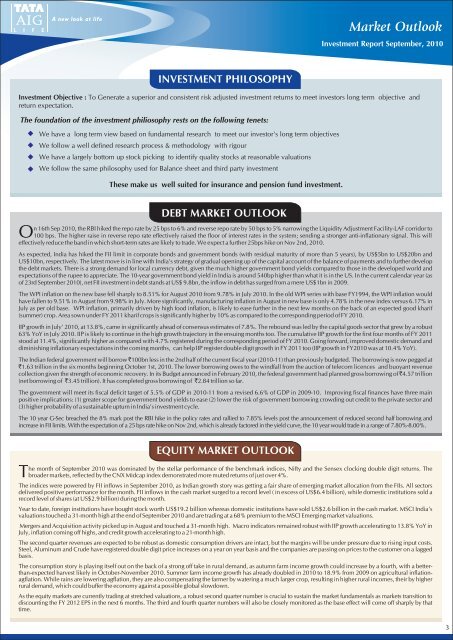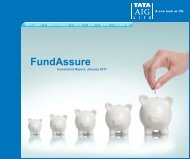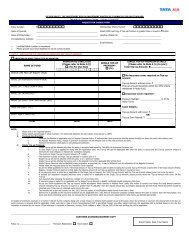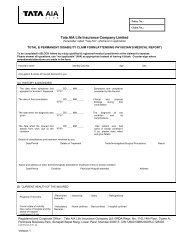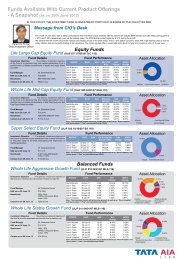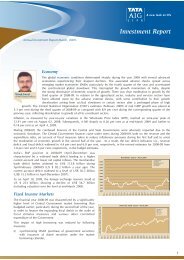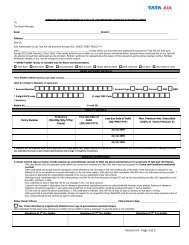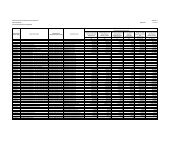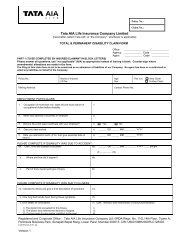September - Tata AIA Life Insurance
September - Tata AIA Life Insurance
September - Tata AIA Life Insurance
You also want an ePaper? Increase the reach of your titles
YUMPU automatically turns print PDFs into web optimized ePapers that Google loves.
Market OutlookInvestment Report <strong>September</strong>, 2010INVESTMENT PHILOSOPHYInvestment Objective : To Generate a superior and consistent risk adjusted investment returns to meet investors long term objective andreturn expectation.The foundation of the investment philiosophy rests on the following tenets:We have a long term view based on fundamental research to meet our investor's long term objectivesWe follow a well defined research process & methodology with rigourWe have a largely bottom up stock picking to identify quality stocks at reasonable valuationsWe follow the same philosophy used for Balance sheet and third party investmentThese make us well suited for insurance and pension fund investment.DEBT MARKET OUTLOOKn 16th Sep 2010, the RBI hiked the repo rate by 25 bps to 6% and reverse repo rate by 50 bps to 5% narrowing the Liquidity Adjustment Facility-LAF corridor toO100 bps. The higher raise in reverse repo rate effectively raised the floor of interest rates in the system; sending a stronger anti-inflationary signal. This willeffectively reduce the band in which short-term rates are likely to trade. We expect a further 25bps hike on Nov 2nd, 2010.As expected, India has hiked the FII limit in corporate bonds and government bonds (with residual maturity of more than 5 years), by US$5bn to US$20bn andUS$10bn, respectively. The latest move is in line with India's strategy of gradual opening up of the capital account of the balance of payments and to further developthe debt markets. There is a strong demand for local currency debt, given the much higher government bond yields compared to those in the developed world andexpectations of the rupee to appreciate. The 10-year government bond yield in India is around 540bp higher than what it is in the US. In the current calendar year (asof 23rd <strong>September</strong> 2010), net FII investment in debt stands at US$ 9.8bn, the inflow in debt has surged from a mere US$1bn in 2009.The WPI inflation on the new base fell sharply to 8.51% for August 2010 from 9.78% in July 2010. In the old WPI series with base FY1994, the WPI inflation wouldhave fallen to 9.51% in August from 9.98% in July. More significantly, manufacturing inflation in August in new base is only 4.78% in the new index versus 6.17% inJuly as per old base. WPI inflation, primarily driven by high food inflation, is likely to ease further in the next few months on the back of an expected good kharif(summer) crop. Area sown under FY 2011 kharif crops is significantly higher by 10% as compared to the corresponding period of FY 2010.IIP growth in July' 2010, at 13.8%, came in significantly ahead of consensus estimates of 7.8%. The rebound was led by the capital goods sector that grew by a robust63% YoY in July 2010. IIP is likely to continue in the high growth trajectory in the ensuing months too. The cumulative IIP growth for the first four months of FY 2011stood at 11.4%, significantly higher as compared with 4.7% registered during the corresponding period of FY 2010. Going forward, improved domestic demand anddiminishing inflationary expectations in the coming months, can help IIP register double digit growth in FY 2011 too (IIP growth in FY2010 was at 10.4% YoY).The Indian federal government will borrow `100bn less in the 2nd half of the current fiscal year (2010-11) than previously budgeted. The borrowing is now pegged at`1.63 trillion in the six months beginning October 1st, 2010. The lower borrowing owes to the windfall from the auction of telecom licences and buoyant revenuecollection given the strength of economic recovery. In its Budget announced in February 2010, the federal government had planned gross borrowing of `4.57 trillion(net borrowing of `3.45 trillion). It has completed gross borrowing of `2.84 trillion so far.The government will meet its fiscal deficit target of 5.5% of GDP in 2010-11 from a revised 6.6% of GDP in 2009-10. Improving fiscal finances have three mainpositive implications: (1) greater scope for government bond yields to ease (2) lower the risk of government borrowing crowding out credit to the private sector and(3) higher probability of a sustainable upturn in India's investment cycle.The 10 year G-Sec breached the 8% mark post the RBI hike in the policy rates and rallied to 7.85% levels post the announcement of reduced second half borrowing andincrease in FII limits. With the expectation of a 25 bps rate hike on Nov 2nd, which is already factored in the yield curve, the 10 year would trade in a range of 7.80%-8.00%.EQUITY MARKET OUTLOOKhe month of <strong>September</strong> 2010 was dominated by the stellar performance of the benchmark indices, Nifty and the Sensex clocking double digit returns. TheTbroader markets, reflected by the CNX Midcap index demonstrated more muted returns of just over 4%.The indices were powered by FII inflows in <strong>September</strong> 2010, as Indian growth story was getting a fair share of emerging market allocation from the FIIs. All sectorsdelivered positive performance for the month. FII inflows in the cash market surged to a record level ( in excess of US$6.4 billion), while domestic institutions sold arecord level of shares (at US$2.9 billion) during the month.Year to date, foreign institutions have bought stock worth US$19.2 billion whereas domestic institutions have sold US$2.6 billion in the cash market. MSCI India'svaluations touched a 31-month high at the end of <strong>September</strong> 2010 and are trading at a 68% premium to the MSCI Emerging market valuations.Mergers and Acquisition activity picked up in August and touched a 31-month high. Macro indicators remained robust with IIP growth accelerating to 13.8% YoY inJuly, inflation coming off highs, and credit growth accelerating to a 21-month high.The second quarter revenues are expected to be robust as domestic consumption drivers are intact, but the margins will be under pressure due to rising input costs.Steel, Aluminum and Crude have registered double digit price increases on a year on year basis and the companies are passing on prices to the customer on a laggedbasis.The consumption story is playing itself out on the back of a strong off take in rural demand, as autumn farm income growth could increase by a fourth, with a betterthan-expectedharvest likely in October-November 2010. Summer farm income growth has already doubled in 2010 to 18.9% from 2009 on agricultural inflationagflation.While rains are lowering agflation, they are also compensating the farmer by watering a much larger crop, resulting in higher rural incomes, their by higherrural demand, which could buffer the economy against a possible global slowdown.As the equity markets are currently trading at stretched valuations, a robust second quarter number is crucial to sustain the market fundamentals as markets transition todiscounting the FY 2012 EPS in the next 6 months. The third and fourth quarter numbers will also be closely monitored as the base effect will come off sharply by thattime.3


